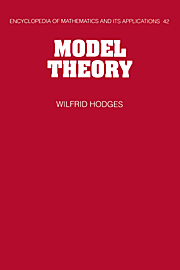Book contents
- Frontmatter
- Contents
- Introduction
- Note on notation
- 1 Naming of parts
- 2 Classifying structures
- 3 Structures that look alike
- 4 Automorphisms
- 5 Interpretations
- 6 The first-order case: compactness
- 7 The countable case
- 8 The existential case
- 9 The Horn case: products
- 10 Saturation
- 11 Combinatorics
- 12 Expansions and categoricity
- Appendix: Examples
- References
- Index to symbols
- Index
6 - The first-order case: compactness
Published online by Cambridge University Press: 08 October 2009
- Frontmatter
- Contents
- Introduction
- Note on notation
- 1 Naming of parts
- 2 Classifying structures
- 3 Structures that look alike
- 4 Automorphisms
- 5 Interpretations
- 6 The first-order case: compactness
- 7 The countable case
- 8 The existential case
- 9 The Horn case: products
- 10 Saturation
- 11 Combinatorics
- 12 Expansions and categoricity
- Appendix: Examples
- References
- Index to symbols
- Index
Summary
A given species of bird would show the same ability of grasping … numbers … but the ability differs with the species. Thus with pigeons it may be five or six according to experimental conditions, with jackdaws it is six and with ravens and parrots, seven.
O. Koehler, The ability of birds to ‘count’, Bull. Animal Behaviour9 (1950) 41–5.
Ravens, so we read, can only count up to seven. They can't tell the difference between two numbers greater than or equal to eight. First-order logic is much the same as ravens, except that the cutoff point is rather higher: it's ω instead of 8.
This chapter is wholly devoted to the model theory of first-order languages. First-order model theory has always been the heart of model theory. The main reason for this is that first-order logic, for all its expressive power, is too weak to distinguish between one large number and another. The result is that there are a number of constructions which give models of a first-order theory, or turn a given model into a new one. In this chapter we study two such constructions. The first is a combination of the compactness theorem with (Robinson) diagrams. The second is amalgamation; it can be seen as an application of the first.
Granted, some fragments of first-order logic are even weaker than the full logic, so that they allow even more constructions.
- Type
- Chapter
- Information
- Model Theory , pp. 264 - 322Publisher: Cambridge University PressPrint publication year: 1993
- 1
- Cited by



